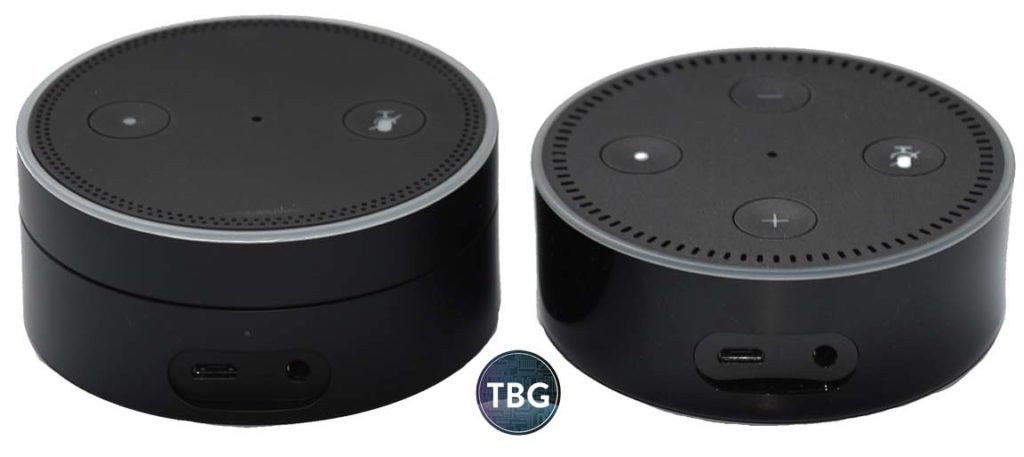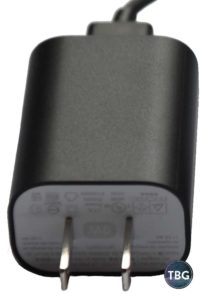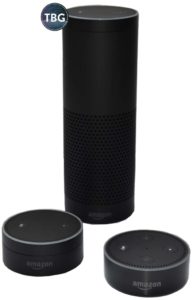Amazon Echo Dot 2nd Gen Review
Pros
Cons
Rating

Introduction
To understand what makes the Amazon Echo Dot 2nd Gen so significant, a little stroll down memory lane might be helpful. The Smart Home market has been evolving at a rapid pace, but one of the factors that has held it back is its origin in smartphone-based apps. Surely, smartphones revolutionized the tech world, and not just because of how they changed the nature and availability of telephonic conversation. Once everyone had a miniature internet-connected computer in their pockets, tremendous new opportunities opened up for technological innovation. But when it came to the Smart Home, there was an inherent problem with smartphones. A mini-computer in your pocket isn’t going to do much for your family or housemates when you’re upstairs, outside, or at work. The Smart Home needed another control device, and it came in the unlikely form of the original Amazon Echo, which launched at and is still sold for $180.
We say unlikely because it was pretty clear from Amazon’s initial marketing of the Echo that it had no idea how much of a role the new device could play in the Smart Home. It focused on reporting weather, sports scores, and telling jokes, all extremely basic tasks. This was in part because Amazon didn’t (and still doesn’t) manufacture any other Smart Home devices. Entering a field where there are a lot of players is always complicated, and even a big company like Amazon, which likely sold nearly every Smart Home product available, still needed to make some adjustments to get a true foothold in the market.
Amazon tried hard with its 1st-generation Amazon Echo Dot, which traded away sound quality for a more compact package and the option to connect external speakers, all at half the price of the original. Alas, that product was virtually stillborn, being cancelled in the summer of 2016, months after release. Our hunch is that despite coming in at just $90, it simply didn’t do enough for non-Smart Home users to justify its huge reduction in sound quality versus the original. Indeed, the full-sized Echo was and still is a fantastic personal audio device. The Echo Dot, not so much.
And that brings us to the Echo Dot 2nd Generation. Released in October 2016, it did everything the original Echo Dot did, but cut the price nearly in half, to $50. That makes it an easy impulse buy for a lot of tech geeks, but what about everyone else? Well, Amazon’s marketing isn’t going to inspire any fence-sitters; it bought high-priced ads during the World Series to show off how a lazy dude could order up an Uber to go two blocks to the gym… seriously, Amazon? Well, we’re going to provide a little more insight into what this cool little gizmo can and cannot do so our readers can decide if this is the right device for them.
Update: See The Tech Buyer’s Guru chat about the Amazon Echo Dot on KGW-8’s Portland Today show!

Description and Features
While the first Echo Dot was small, the new Echo Dot 2nd Gen is even smaller. It’s the exact same 3.38″ (84mm) in diameter, but it’s a 1/4-inch shorter, at just over 1.25″ (32mm) tall. And not that it matters all that much for a device you’ll probably leave on a counter or table and never move again, but the new Echo Dot weighs 5.6 ounces, versus 8.8 ounces for the original. In the world of audio devices, a lower weight isn’t necessarily good for audio reproduction, but in this case, we didn’t notice any degradation in sound quality.

The 2nd Gen Echo Dot also has a shiny plastic exterior, which some people may view as a bit “jazzier” than the original. While this is often a no-no for a touch-based product, the Echo Dot being voice-based means that if you’re touching it often enough to get it covered in fingerprints, you’re probably doing it all wrong! Amazon has also added two additional physical buttons, despite its deep-seated desire to make this a hands-off product. The original had a button to shut off the microphone (for privacy) and an action button (to engage the Echo voice assistant without saying the wake word, Alexa or Echo). It also had a rotary dial to control volume, but while this was slick, it wasn’t all that obvious. The 2nd Gen device adds volume buttons to match the other two buttons. After months of testing various Echo products, we think this was the right move; for a device that might be placed bedside, there’s nothing more frustrating than asking Alexa to lower the volume at night only to be misunderstood and have Alexa loudly proclaim that she couldn’t answer your question! Ultimately, sometimes using a good old-fashioned button that you can see and feel is the best approach.

On the back, you have the micro-USB input for power (the Dot must be plugged in to operate), along with a 3.5mm audio output for connecting to external speakers. While the original Echo Dot included a cable to connect to any device with a 3.5mm input, Amazon has dropped that accessory from the bundle on the 2nd Gen product, likely to help in hitting the $50 price point. But that was of limited use anyway, as it only offered 3.5mm-to-3.5mm connections. Stereo owners may want (or need) stereo RCA connections. We tested it with a $4 adapter from Tripp Lite, and it worked just fine connected to our AV receiver.
In a nod to users who might place the Echo Dot in a bedroom, Amazon has jettisoned the LED power indicator on the back of the unit, which could light up a room in the dark, whether you wanted a nightlight or not. One simple issue we really wish Amazon would still address, however, is the shape of the Echo’s power adapter. The Echo Dot fits perfectly on just about any table top, dresser, or bookcase, but its adapter can often limit where you ultimately put it, as it sticks out a 3 inches from the wall socket. A low-profile adapter would be much appreciated. We’ve actually had to use low-profile extension cords in some locations just to get the Echo plugged in where a cabinet sat close to a wall outlet.
All right, let’s move on to how the Echo Dot performs in real-world use, especially when it comes to voice recognition. Is it better that the previous gen, or just cheaper? Read on to find out!

Performance
We put the Dot 2nd Gen to the test in an actual home, using it for nearly a month to truly understand all its strengths and weaknesses. We were quite familiar with the Echo ecosystem, having previously used the original Echo and Echo Dot. The big new addition is networked voice recognition, and it offers lots of promise, as well as a little peril.
Now, it’s important to understand that this was a critical update to the Echo system architecture. Previously, if you voiced a request and multiple Echos heard you, they’d each take action independently. This led to utter nonsense when different tunes were played or the weather was reported out of sync from multiple devices. Basically, it was an untenable situation for Amazon given its push to have not just one in every home, but one Echo in every room. This goal has been made clear by Amazon somewhat ambitious buy 5 get 1 free campaign. We’re not sure any household actually needs half a dozen echos, at least not until Amazon makes the Echo much more essential to daily life.
And here’s the drawback to networked voice recognition: the new feature, which was pushed out to all Echo devices since they all must play a role, has injected a considerable delay in the Echo’s response time. To determine which Echo will respond, voice telemetry must be calculated to determine which device is closest to the user. We suspect that this data goes back to the Amazon mothership, as the Echo system has no main hub. You often need to wait up to a full second after saying the wake word before issuing your request. If you don’t, your nearby Echo just won’t understand, because it’s not yet the designated actor in the system. And we’ve found that all of our Echos just get it wrong a bit more often than they used to, a problem that could probably be fixed eventually through additional updates to the server-side language processing.
Now, all of this may sound frustrating, and it is. But the benefit of meshed voice recognition cannot be underestimated. We’re hoping that with additional fine-tuning to the software, more sensitive microphones, and perhaps a local hub function (where one Echo in a household determines which one should respond to a command), all of this will be sorted out when the 3rd Gen Echo Dot comes along.
We’ve covered voice input, but what about audio output? Well, the integrated speaker is functional, certainly good enough to report the weather or the news, but it isn’t what you’d want to use to listen to music on a regular basis. Hooked up to our Denon AV receiver using a third-party cable adapter, we made the most out of the music streams the Echo Dot could provide, although audiophiles will want to keep in mind that this isn’t even CD-quality sound, let alone lossless, and you can’t yet connect to higher-quality music stashed on your home network. Not too surprisingly, Amazon rolled out a brand-new streaming music service to coincide with the launch of the Echo Dot 2nd Gen, called Amazon Music Unlimited. Interestingly, it has a special discounted price for owners of one Echo device, which doubles for anyone with more than one. This is no doubt how Amazon plans on monetizing the Echo Dot, which is likely a loss leader at its $50 asking price.
Like the original Dot, but unlike the full-sized Echo, the Echo Dot 2nd Gen includes Bluetooth functionality for connecting to wireless speakers. We tested it extensively with the iClever Bluetooth Speaker, and found it to work exactly as expected. All you have to do once the speaker is put into pairing mode is to ask Echo to connect to your Bluetooth speaker and Echo will take care of the rest. It’s even simpler each time you connect it from there on out. Still on the wish list of many enthusiasts, and something the new Google Home competitor offers, is synced music playback across devices. That will really make multiple Echoes appealing for streaming music fans.
But from our point of view, to really get the most out of Echo, you have to step beyond what Amazon’s services can provide. Therefore, you’ll want to pick up the bargain-priced Wink Hub to allow for nearly-limitless home integration. While the Echo Dot can interface directly with Smart Home devices that connect to the Internet, like the Ecobee 3 thermostat, or devices with bundled hubs, like the Philips Hue Bulb Kit and Lutron Caseta Switch Kit, anyone with grand Smart Home aspirations will want to skip proprietary solutions and go for a universal hub like Wink. It allowed us to use Lutron Caseta dimmer switches without the Lutron hub, Leviton dimmers, Cree Connected 60W-equivlent bulbs, GE Link floodlights, and Leviton plug-in appliance modules, as well as the aforementioned Ecobee. Asking an Echo to shut off all the living room or TV room lights when you sit down to watch a movie, or to adjust the temperature by voice command, is an example of the future here today. It’s been a long time coming, but Amazon stumbled upon how to launch us into the Star Trek age!
Conclusion
While we’ve clearly taken issue with some of the shortcomings of the Echo Dot 2nd Gen, they are really more critiques of Amazon’s Echo ecosystem, which has grown beyond Amazon’s simple aspirations of encouraging consumers to buy more products. Echo has at this point earned practically essential status in the Smart Home environment. Amazon’s still in an awkward position, however, as it tries to market features of the Echo that it has little to no control over, but that hasn’t changed with the Echo Dot 2nd Gen. What has is the price, and we’re betting that consumers will now view the Echo Dot as something worth investing in even if they don’t know any better than Amazon does what the full potential of the product might be.
The Echo Dot 2nd Gen is available for $49.99 shipped from Amazon, as of our publication date, but not surprisingly is on back-order for the time being, just as the original Echo and Echo Dot were upon their release.
To learn more about setting up your own Smart Home, see our Smart Home Buyer’s Guide, our Smart Lighting Buyer’s Guide, and our Complete Guide to the Smart Home, which provides an overview of everything that is possible in smart home tech today!

